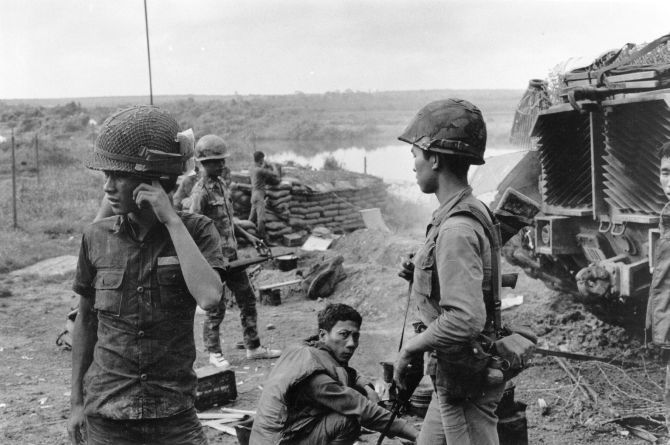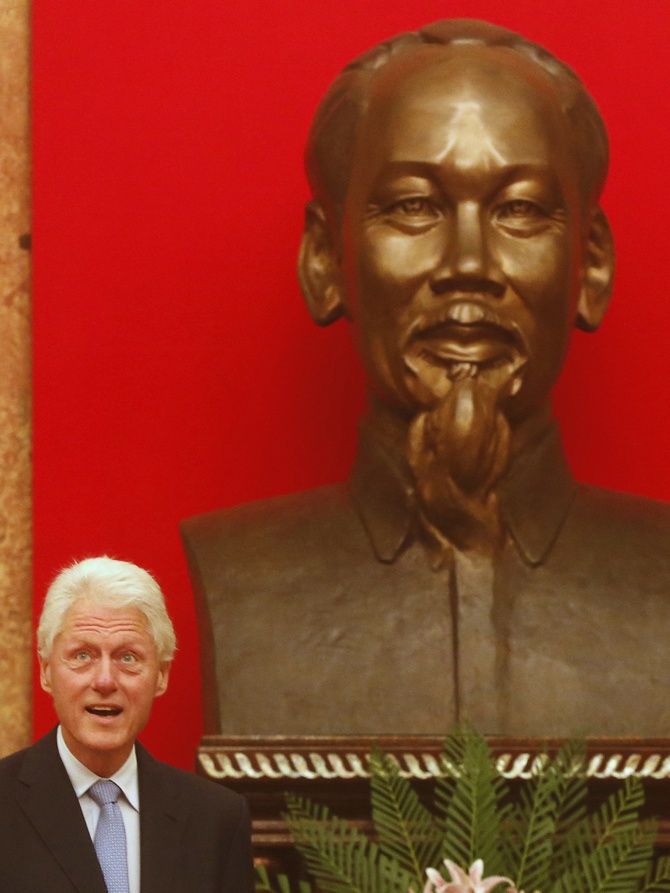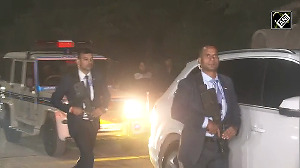'Vietnam had shown that the world could indeed be changed and the power of the people was more than the power of the State.'
'America's withdrawal from Vietnam was an inspiring moment for all of us. We believed it was a glorious victory of ideology and spirit, as historic as the defeat of the Nazis.'
Kumar Ketkar remembers the end of the Vietnam War 40 years ago.

I distinctly remember the tense and confrontationist atmosphere in Bombay when Madame Binh visited the city in July 1970.
Madame Nguyen Thi Binh was the Communist leader of South Vietnam. The peasants organised by the Communist Party there were termed the Vietcong by the US military and the American media. So when the news appeared in the Indian press that a senior Vietcong leader, Madame Binh, would visit Bombay (it was not Mumbai then), we were excited.
Madame Binh became the foreign minister of Vietnam after it was liberated and united on April 30, 1975. Exactly 40 years ago.
I was then a student union activist. Most student and youth movements were under the influence of the Left. Our student union was affiliated to the Communist Party.
We got a call from our leaders that we should go in a morcha to the airport to welcome Madame Binh. She was to come to the Kamani Employees Union hall at Kurla (north-central Mumbai) and was to be felicitated there by the trade union organisations.
But it was not going to be smooth. The Shiv Sena and Jan Sangh youth organisations were to organise parallel morchas to protest her visit.
They were more vociferous and larger in numbers. The atmosphere was extremely polarised. Though the city had a strong Communist base with control of most trade unions, the Left was on the defensive.
Just a month earlier, militant Communist leader and MLA Krishna Desai had been murdered by Shiv Sena activists. It was the first-ever political murder in Maharashtra. Though the Shiv Sena was born only four years earlier, in 1966, it had become a very violent and aggressive political front, subtly encouraged by then Congress chief minister V P Naik.
The Sena also had the backing of the industrial lobby, which saw in the saffron brigade, gangs of men to break strikes or Communist agitations.
Originally the Sena was against the lungiwallahs or Madrasis (to the Sena, all South Indians were Madrasis). Its initial attacks were on Udipi hotels, South Indian shops in Matunga, Madrasi clerks and stenographers in government and private offices.
Later, the Sena shifted its stance and wanted to make Bombay free of Communists.
Shiv Sainiks entered factories where workers were on strike, attacked them and their leaders. They also attacked Communist Party offices in the textile belt of Parel-Lalbag (central Mumbai). The Communist cadres were committed, but on the defensive. Violence was in the air as the Sainiks roamed the streets.
Bal Thackeray (he became Balasaheb much later) used to threaten the Communist leaders at every public meeting. His aim was to make Bombay 'Lalbhai Mukta' (free of Communists), as it were.
The Sena morcha to protest against Madame Binh was more a follow-up of that anti-Red mobilisation. Otherwise, the Sainiks had neither knowledge nor concern for the Vietnamese Liberation Struggle that was at its peak in South-East Asia and was the most dominating political issue at the time.
The youth all over the world, particularly in the US and Europe, had become anti-war and even pro-Vietnam, particularly after the massive Tet Offensive in 1968, launched by the Vietnamese against American aggression. (The offensive is named such because it was launched on January 31, the lunar year holiday called Tet).
Though many Vietnamese died in that offensive, it turned the tide of the war.
More and more 'body bags' carrying the corpses of American soldiers were coming to the shores of the United States. The televised images of those body bags and horribly injured US soldiers, Life magazine's photographs of the devastated families of those soldiers, the growing media expose of the deceit and duplicity of the Nixon-Kissinger regime in the conduct of the Vietnam War, the rising revolt on US university campuses and even the newly found attraction towards Communist ideology, mainly inspired by Vietnamese leader Ho Chi Minh and even by Mao's Cultural Revolution in China were causing concern across right wing establishments.
Though the Communists in Bombay were on the defensive, globally, the ideology seemed to attract new supporters. The idea of the 'New Left' was born in the 1960s.
The rebellious decade, specifically, 1965 to 1975, celebrated everything from the Beatles to Che, from Hippies to LSD, from Mao to Malcom X, from Martin Luther King to Cohn-Bendit, from Sartre to Norman Mailer, from counter-culture to SDS and the Weathermen and, of course, from the Vietnamese spirit to the Naxalite movement.
The world appeared to be in a new revolutionary renaissance. That global mood gave us the confidence and courage to march to the airport to welcome Madame Binh to Bombay, despite the fact that we were outnumbered.
Our slogan was "Mera Naam Tera Naam, Vietnam-Vietnam," and theirs was, of course, "Jala Do, Jala Do, Lal Jhanda Jala Do." The slogan shouting could have easily degenerated into a riot.
The police were deployed to ensure that the Sainiks and comrades did not clash physically.
This mood and momentum continued for much longer. We were inspired by the courageous American media exposing the American establishment and war-monger politicians. Journalists like Neil Sheehan, Gore Vidal and I F Stone, writers like Noam Chomsky, Watergate warriors like Bob Woodward and Carl Bernstein and Ben Bradlee and many others had become icons among the metropolitan youth in Bombay.
One of the reasons many of us joined journalism in the early 1970s was because we thought the press was a weapon to change the world. Vietnam had shown that the world could indeed be changed and the power of the people was more than the power of the State.
After the expose of the Pentagon Papers by Daniel Ellsberg in The New York Times and the deception games in the Watergate scandal, the Vietnam War entered the last phase. Now nobody doubted the inevitable victory of the Vietnamese in the war.
Nearly three million Vietnamese were killed in the war, many of them in the wave of bombings by the US Air Force, hundreds and thousands of villages were razed, human brutality had crossed its limits and yet they were winning the war.
So there was hope in the world and the press was the medium to spread the message.
The whole world had turned against President Richard Nixon and the arrogance of American power. The strong protagonists of the US and the Right had lost the ideological and perception battle.
There was no option left for Nixon, but to resign, which he did on August 9, 1974. Nearly eight months later, US forces conceded a humiliating defeat, on April 30, 1975.
The next day was May 1 -- International Workers Day and also the new United, Liberated, Communist Vietnam Day.
It was an inspiring moment for all of us. We believed that it was the glorious victory of ideology and spirit and as historic as the defeat of the Nazis exactly 30 years earlier in the same week in 1945.
Hitler had committed suicide on April 30, 1945. That same day, 30 years later, American forces left Vietnamese soil. The simple men and women of Vietnam had defeated the French military in 1953 after nearly eight years of a long and bizarre war, only to realise that their war for self determination was not over.
American forces entered in place of the French and the war continued, and intensified in the 1960s.

With the humiliating defeat of the US, the 'Thirty Year War' (1945 to 1975) was over and a new Vietnam was born. Exactly 25 years later, I visited Vietnam and travelled within the North and South, from Hanoi to Saigon, now renamed Ho Chi Minh City.
The whole generation born after the war had come into their twenties and thirties. The country was joyously, but anxiously, awaiting the arrival of US President Bill Clinton. There was no bitterness, which I found strange and intriguing. Vietnamese television telecast song and dance, Disney and Hollywood.
The youth knew about the war because family members had lived through those horrifying times. But they had no personal experience or memory. Young schoolgoing children were as chirpy as anywhere, in their uniforms and schoolbags.
Nobody could have said, looking at their faces, that just a generation ago, they were changing the world, its mood, its politics, its spirit.

I met a middle aged man on the train from Hanoi to Ho Chi Minh City. I asked what his experience of the war was. He was in his teens when the war raged. He had seen the blood and gore, bombings and killing, horrendous helicopters and hugely built GIs with heavy guns and intimidating uniforms.
In broken English, he said, "We don't look at the past. It is not worth remembering. We look towards the future. We don't want to carry on the bad memories and bitterness. The coming years and these young kids will have a happy future and happy memories."
He was not a poet, journalist or philosopher, but he made me introspect intensely.
Kumar Ketkar is a distinguished commentator and editor.
REDIFF RECOMMENDS










